Once, I couldn’t climb stairs without my legs burning. Simple tasks like carrying groceries or playing with my kids left me tired. But, when I started focusing on leg strengthening exercises, everything changed.
Strong legs are not just for athletes. They are the base of our everyday movements. Whether you want to hike longer, lift heavier, or feel more confident on your feet, this guide will help. We’ll show you exercises you can do at home or at the gym, from squats to plyometrics.
These exercises will boost your mobility and endurance. Let’s turn those wobbly knees into strong pillars.
Key Takeaways
- Strong legs improve daily activities like walking, climbing stairs, and lifting.
- Exercises to improve leg strength can be done anywhere with minimal equipment.
- Leg strengthening exercises reduce injury risk and enhance athletic performance.
- This guide covers bodyweight, weighted, and plyometric routines.
- Nutrition and recovery are key to maximizing gains.
Understanding Leg Strength and Its Importance
Leg strength is more than just lifting weights. It’s the power your lower body uses to move and stay stable. A regular leg workout routine or focused
What is Leg Strength?
Leg strength shows how well your quads, hamstrings, and calves work together. It’s tested through jumps, squats, or resistance training. This strength helps with walking, climbing stairs, and staying balanced during sudden movements.
Benefits of Strong Legs for Overall Health
- Improves mobility and reduces injury risk by strengthening joints and muscles.
- Enhances metabolic health by burning calories and boosting metabolism.
- Supports posture by balancing muscle groups and reducing back strain.
- Builds bone density and cardiovascular health through dynamic movements.
Strong legs also help with hormonal health, triggering growth factors that help muscles repair. A leg workout routine isn’t just for athletes—it’s key for everyday wellness.
Key Muscle Groups Involved in Leg Strength
Building leg strength starts with knowing the muscles involved. I’ll break down each major group and their roles. These muscles work together to power movements like running and jumping. Ignoring any group can lead to imbalances and injury.
⏳ Get Your Energy Back with Discount!
Quadriceps
Quadriceps sit at the front of the thigh. They extend the knee and help straighten the leg. Weak quads make climbing stairs harder. Quad exercises like squats build their strength. These muscles also stabilize the knee during activity.
Hamstrings
Hamstrings run along the back of the thigh. They bend the knee and support hip extension. Hamstring exercises like deadlifts strengthen them. These muscles are vital for sprinting and preventing knee instability.
Calves
Calves are in the lower legs. They control ankle movement, aiding every step you take. Exercises like calf raises build their strength. Strong calves boost jumping power and walking efficiency.
Glutes
Glutes are the buttocks muscles. They extend and stabilize the hips. Squats and lunges engage them, enhancing athletic performance. Strong glutes improve posture and reduce back strain.
Each group contributes to leg function. Overlooking one area leaves room for injury. Balancing strength across all four groups maximizes power and safety. Focus on targeted exercises for full-body leg health.
Bodyweight Exercises for Leg Strength
Building strong legs doesn’t need heavy weights. Squats and lunges are great for working out at home or outside. They target big muscles and boost balance and movement.
Squats: The Foundation of Leg Strength
Learn squats for leg strength to work quads, glutes, and hamstrings. Stand with feet apart, lower hips as if sitting, and keep knees in line with toes. Don’t round your back. Try pistol or jump squats for more challenge.
- Beginner: 3 sets of 10 reps
- Pro tip: Pause at the bottom to build endurance
Lunges: Building Balance and Stability
Lunges for leg muscles test one-leg strength. Step forward, lower hips until knees are 90 degrees. Switch legs for each rep. Try reverse lunges for glutes or walking lunges for movement.
Focus on smooth movements to avoid injury. Aim for 3 sets of 12 reps per leg.
Step-Ups: Functional Strength Training
Use a bench or stair for step-ups. Step up, push through the heel, then lower slowly. It’s like climbing stairs. Start with 3 sets of 10 steps per leg, then increase height or speed.
Do these exercises 2-3 times a week. Get better by adding holds, increasing reps, or trying plyometric versions. Stick to proper form for the best results.
Weighted Exercises for Enhanced Leg Strength
Adding weight to your leg workout routine unlocks new levels of muscle growth and power. These exercises demand focus on form and gradual progression to maximize benefits safely.
Barbell Squats: Advanced Leg Workout
Barbell squats build foundational leg strength using a weighted bar. Two key variations include back squats (bar on upper traps) and front squats (held across the shoulders. Start with an empty bar to master form before adding weight. Breathe deeply—inhale on descent, exhale when standing. Always keep your chest up and knees aligned with toes.
Deadlifts: A Total Body Strength Enhancer
Deadlifts engage legs and the core. Choose between conventional (feet hip-width apart) or sumo (wide stance, toes turned out) styles. A certified trainer once said:
“Deadlifts strengthen hamstrings and glutes while improving posture when done correctly.”
Focus on hinging at the hips, driving through heels, and avoiding rounded backs.
Leg Press: Targeting Major Muscle Groups
Leg press machines offer controlled resistance. Adjust foot placement to shift focus: wider feet emphasize quads; closer feet engage glutes. Start with light weights to learn the sled’s motion. Progress gradually to heavier loads while maintaining smooth movement. Pair this with bodyweight lunges for balanced development.
Incorporate these into your leg workout routine 1-2 times weekly. Prioritize mastering form before increasing weight. Always warm up with dynamic stretches before lifting.
Plyometric Exercises to Boost Power
Plyometric exercises, or jump training, are a great way to increase explosive power in your legs. They use your body’s natural stretch-shortening cycle to boost force in your quads and glutes. These exercises are perfect for those looking to move beyond basic leg strength workouts.
They help build athleticism and strengthen your lower body. Always start with these after you’ve built a solid base with exercises like squats or lunges.
Box Jumps: Explosive Leg Strength
Begin with a box that matches your current skill level. Stand 12-18 inches away, swing your arms, then jump up onto the box. Land softly with your knees slightly bent. Increase the box height slowly to avoid injury.
I focus on proper form over height to ensure safety and maximize benefits.
Jump Squats: Power and Strength Combined
Start in a squat, then jump up. Land softly and repeat. Beginners should start without weights to get the hang of it. Add light dumbbells once you’re comfortable.
This exercise combines strength and explosiveness, working many lower body muscles at once.
Combine these plyometric exercises with traditional lower body workouts for a well-rounded routine. Start with 2-3 sessions a week, with 48 hours of rest in between. Prioritize quality over quantity to avoid overtraining. Focus on mastering form before increasing intensity.
Resistance Band Workouts for Legs
Resistance bands are a game-changer for leg strengthening exercises. They are affordable and easy to carry. They add a dynamic resistance to your workouts, challenging your muscles in every move. You can use them at home or in the gym to safely boost your strength.
🌟 Boost Your Well-Being Today!

Lateral Band Walks: Strengthening the Hips
Start by wrapping a mini band above your knees. Then, step sideways in a low squat, keeping the band tight. This targets your hip abductors, which are often overlooked in regular workouts.
Strengthening these muscles helps improve knee stability. It also lowers the risk of injuries during activities like running or jumping.
Band-Resisted Squats: Increasing Intensity
For this exercise, loop a band above your knees or around your upper back and shoulders. Squat while resisting the band’s pull. This move focuses on your outer thighs and glutes, making squats more effective.
Adjust the band tension to fit your fitness level. This way, you can always challenge yourself.
| Exercise | Focus | Benefits |
|---|---|---|
| Lateral Band Walks | Hip abductors | Knee stability |
| Band-Resisted Squats | Quadriceps, glutes | Increased muscle activation |
| Monster Walks | Glute activation exercises | Core engagement |
Use bands with glute activation exercises like banded glute bridges. Place the band above your knees and push outward while lifting your hips. This isolates the glutes for targeted growth.
Mix band work with barbell or bodyweight moves for hybrid routines. Bands are great for home workouts and help improve your form during lifts.
Incorporating Leg Strength into Your Routine
Building stronger legs is more than just doing a few exercises. A good leg workout routine needs the right mix of how often you work out, what exercises you do, and how much rest you take. Let’s explore how to set up your training for the best results.
How Often Should You Train Leg Muscles?
Start with 2–3 leg workouts a week if you’re new to it. If you’re more experienced, you can do 4 days a week, but make sure you rest well. Too much training can lead to soreness or lower performance. Here’s a simple guide:
| Experience Level | Training Frequency | Sample Routine |
|---|---|---|
| Beginner | 2x/week | Squats + lunges + calf raises |
| Intermediate | 3x/week | Deadlifts + plyometrics + resistance band work |
| Advanced | 4x/week | Barbell squats + Olympic lifts + high-volume circuits |
Combining Leg Exercises for Maximum Effect
Use a mix of big exercises and smaller ones to work all your leg muscles. Here’s how:
- Begin with big lifts like squats when you’re most energetic.
- Switch between days focused on legs and days for active recovery.
- Add exercises to improve leg strength like box jumps on rest days.
“The key is consistency—not intensity. Progress comes from gradual increases in volume over time.”
Change your leg workout routine based on what you want to achieve. For strength, do low reps with heavy weights. For endurance, use lighter weights and more reps. Always warm up with dynamic stretches to avoid injuries.
Stretching Techniques for Flexibility
I make stretching a top priority to boost leg strength. Doing dynamic stretches before and static stretches after workouts keeps muscles ready. This approach also enhances form and lowers injury risks.

Importance of Stretching for Leg Strength
Dynamic stretches, like calf raises, prepare muscles for exercise. They warm up without overloading. After working out, static stretches, such as hamstring exercises, help muscles recover and grow stronger.
Best Stretches for Legs Pre- and Post-Workout
Here’s a simple guide for choosing the best stretches:
| Pre-Workout Dynamic Stretches | Post-Workout Static Stretches |
|---|---|
| Leg swings (10 reps per side) | Hamstring stretches (30 seconds per side) |
| Walking lunges (10 steps per leg) | Calf stretches (20 seconds per side) |
| Calf raises (3 sets of 15 reps) | Glute bridge stretch (15-30 seconds) |
Start with calf raises for a strong leg warm-up. Hamstring stretches improve flexibility. Spend 10-15 minutes each day to see improvements.
Preventing Injury While Strength Training
Building leg strength with squats for leg strength and lunges for leg muscles needs safety focus. Bad form or overdoing it can cause injuries. Here’s how to train safely and avoid setbacks.
Common Injuries in Leg Workouts
Patellofemoral pain, hamstring strains, and ACL tears often come from wrong movements or too much weight. Squats need the right knee alignment. Lunges require balanced foot placement. Lower back pain can happen if you lift too soon without mastering the form.
Tips for Safe Exercise Practices
Follow these tips to reduce risks:
- Warm up dynamically: Start with brisk walking or marching to get muscles ready.
- Master form first: Practice squats without weights until your knees track over your toes. For lunges, land softly to avoid jarring your joints.
- Gradual load increases: Only add weight after you’ve mastered the technique. Increase by 5% each week.
- Listen to your body: If you feel sharp pain, stop. Soreness is okay, but sharp pain means you need to rest.
- Strengthen stabilizers: Weak glutes or hips can mess up your form during squats or lunges.
Preventing injuries isn’t about avoiding challenges—it’s about knowing your limits. Focus on safety to build strength steadily. Remember to prioritize alignment, patience, and recovery for safe progress.
Nutrition for Muscle Recovery and Growth
Building strong legs is more than just exercises to improve leg strength. You also need the right food to fuel your leg workout routine and help your muscles recover. Let’s explore how to feed your muscles right.
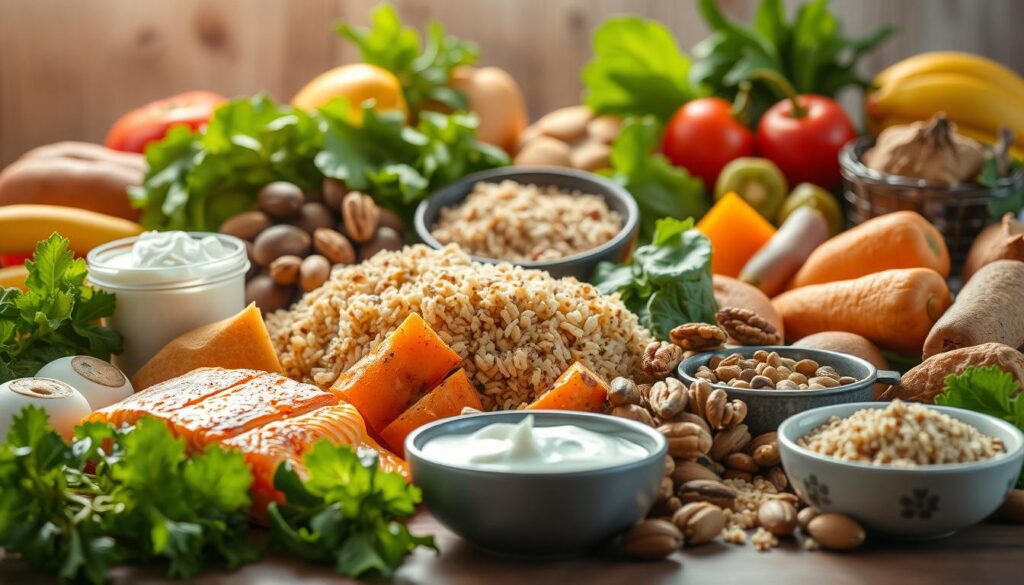
Key Nutrients for Leg Strength
- Protein: Eat 0.7–1 gram of protein for every pound of your body weight each day. Foods like eggs, chicken, and Greek yogurt help repair muscles.
- Carbohydrates: Choose complex carbs like oatmeal and sweet potatoes. They help refill energy lost during tough leg workouts.
- Micronutrients: Magnesium in spinach and potassium in bananas boost muscle strength. Vitamin D and calcium from dairy or fortified plant milks keep bones strong.
Post-Workout Meals: What to Eat
Right after your workout, focus on:
- Whey protein shake with almond butter and frozen berries for fast muscle repair.
- A turkey wrap with avocado and quinoa salad for lasting energy.
- Edamame beans or a lentil bowl for plant-based protein.
Don’t forget to drink plenty of water. Aim for 16–20 oz to replace lost electrolytes.
Match your diet with your workout plan for better results. Every exercise session needs a nutrition plan as solid as your squats.
Choosing the Right Footwear for Leg Exercises
Choosing the right shoes is crucial for leg workouts. The right shoes help you perform better and protect your joints. The wrong shoes can cause injuries or misalignment. Here’s how to choose the best shoes for you.
Features of Good Workout Shoes
When picking shoes, look for these important features:
- Flat soles are great for stability in exercises like calf raises. They keep your energy focused on the ground.
- Features like reinforced heels and arch support help prevent ankle rolls in exercises like lunges or squats.
- The cushioning level depends on the exercise: less for weightlifting, more for running and plyometrics.
Recommendations for Running and Strength Training
Choose shoes that match your activity for better performance and safety. For strength training, flat-soled shoes are best for calf raises. Running shoes should be cushioned for impact during sprints and jumps.
- For weightlifting, go for flat-soled shoes like Nike Metcon or Reebok Nano. They keep you stable during squats and deadlifts.
- For plyometrics, choose cushioned shoes like Adidas Ultraboost. They reduce impact during jumps and calf raises.
- For running, pick lightweight, supportive shoes like Asics Gel-Kayano. They help during long runs involving quad exercises.
Replace your shoes every 300–500 miles or when the soles wear out. This keeps your support during all leg exercises.
Tracking Your Progress in Leg Strength Training
Building stronger legs needs consistent effort and clear goals. Whether you’re working on glute activation exercises or hamstring exercises, tracking your progress is key. Here’s how to keep moving forward without doubt.
How to Set Realistic Goals
Begin with glute activation exercises goals that are Specific, Measurable, and Time-bound. For example, aim to hold a single-leg deadlift for 10 seconds longer each week. Also, set process goals like doing hamstring exercises three times a week.
Adjust your goals based on where you start. Beginners might focus on getting the form right. Advanced trainees can aim to lift more weight.
Tools for Monitoring Improvement
Keep a training log to track sets, reps, and weights for moves like step-ups or hamstring exercises. Apps like Strong or JEFIT can show your progress visually. Test your wall sit duration monthly or measure vertical jumps after glute activation exercises.
Take photos of your squat form progression or weigh yourself weekly. Celebrate small victories, like adding 10 pounds to a leg press. This keeps you motivated.
FAQ
What are some effective exercises to improve leg strength?
How often should I include leg exercises in my workout routine?
What are the benefits of squats for leg strength?
Are lunges effective for building leg muscles?
How can I strengthen my calves at home?
What types of hamstring exercises should I include in my leg routine?
Why is glute activation important in leg-strengthening exercises?
What should I eat for optimal recovery after leg workouts?
How can I reduce the risk of injury while strengthening my legs?
Did you like this article? See also: https://powerfitguide.com/get-fit-with-functional-workouts-for-weight-loss/

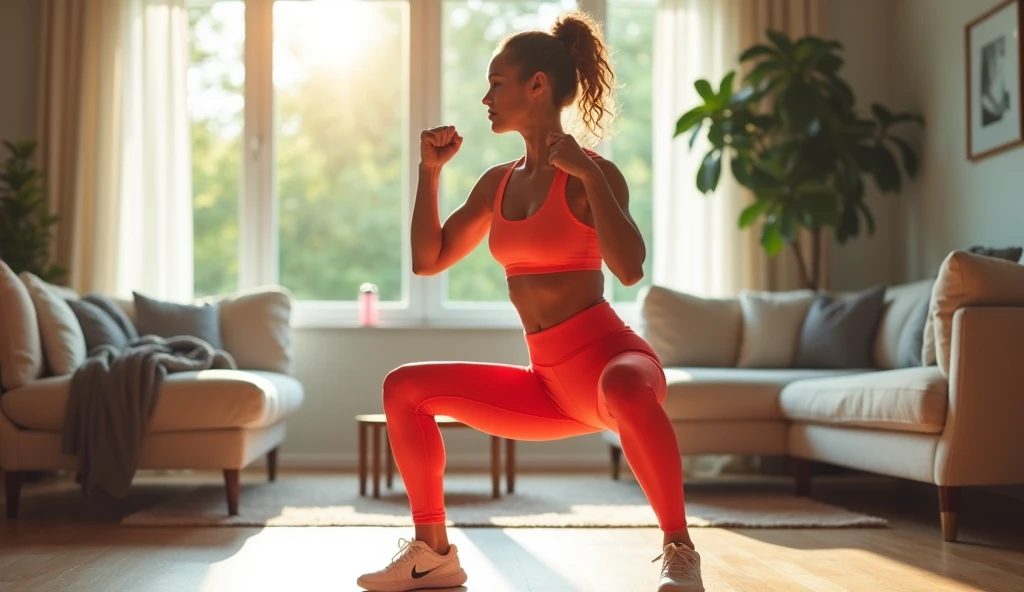


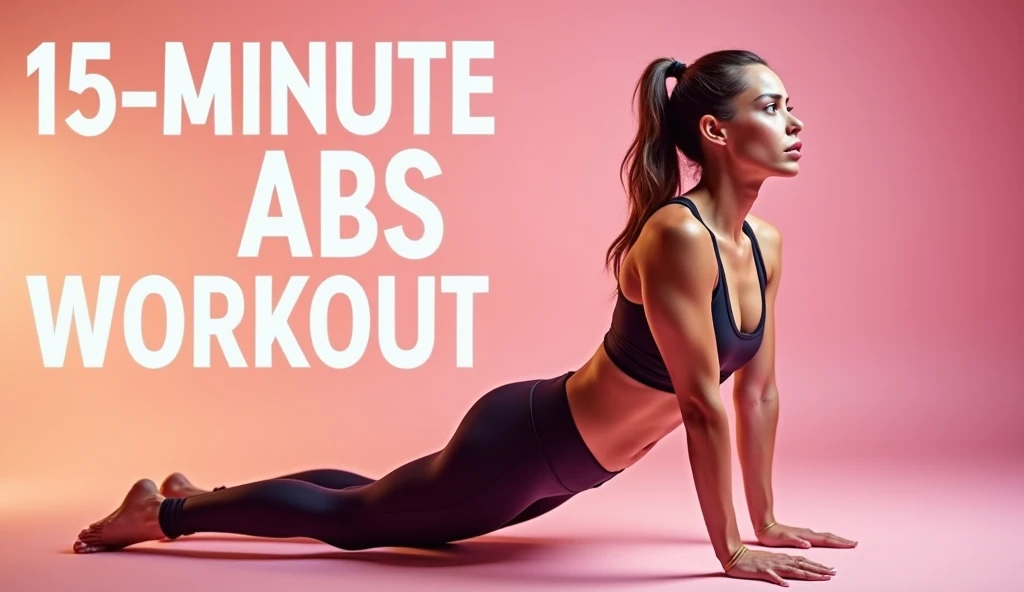
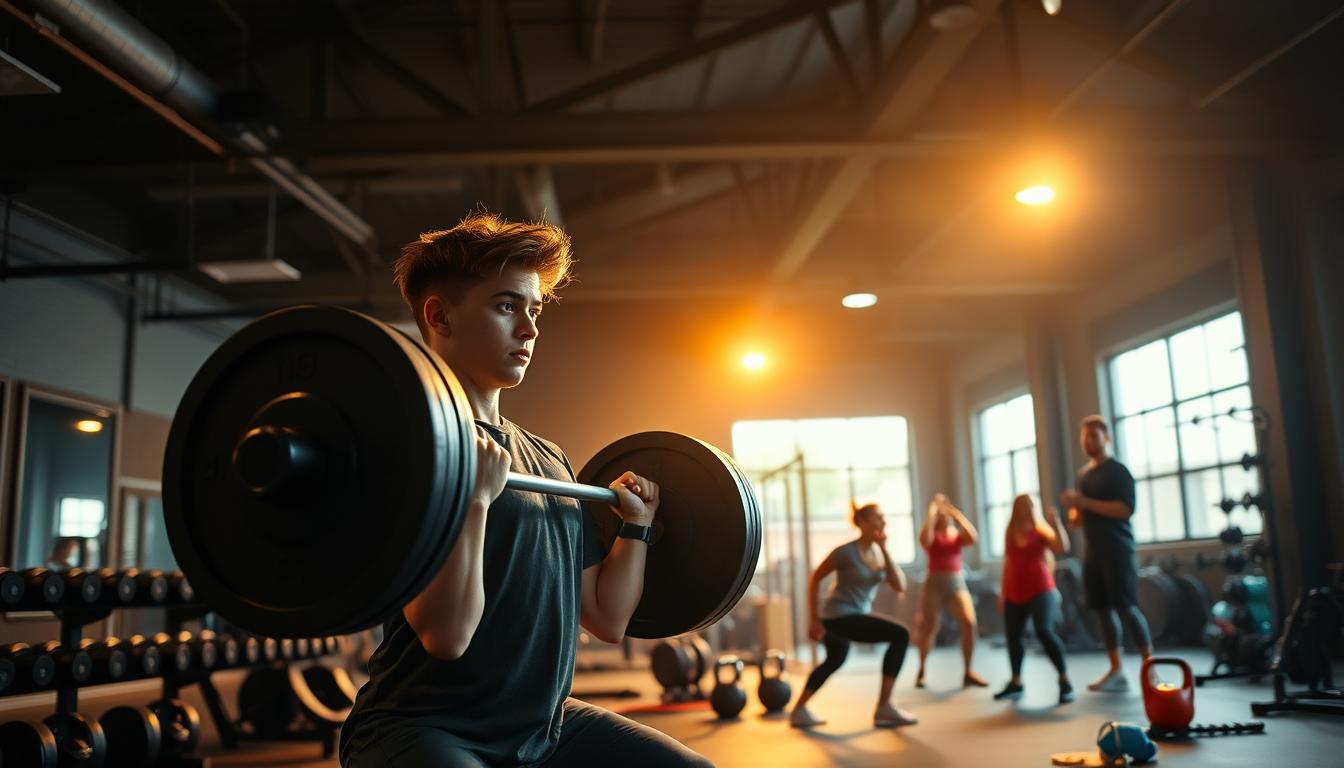
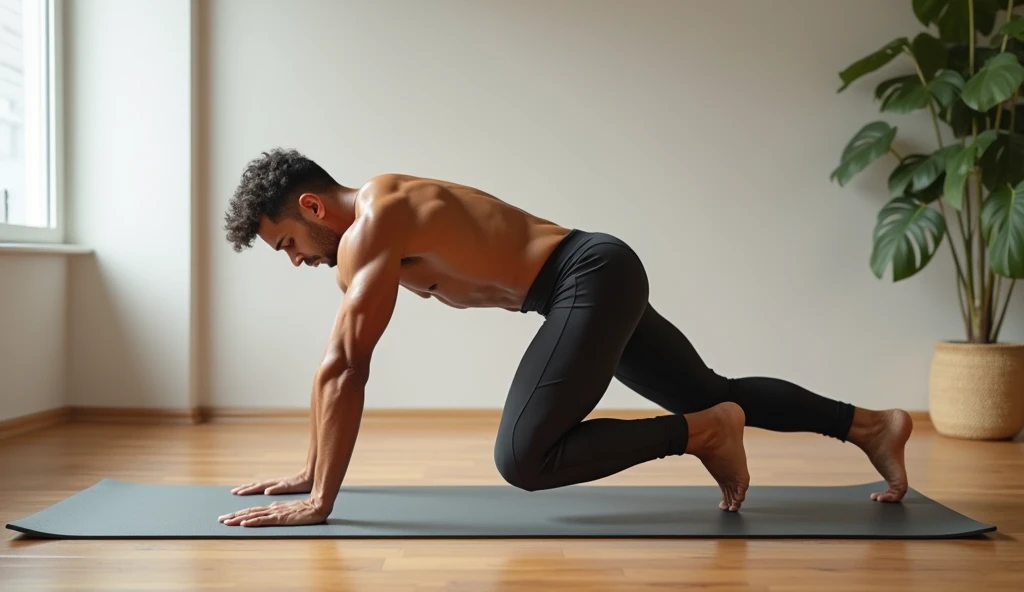
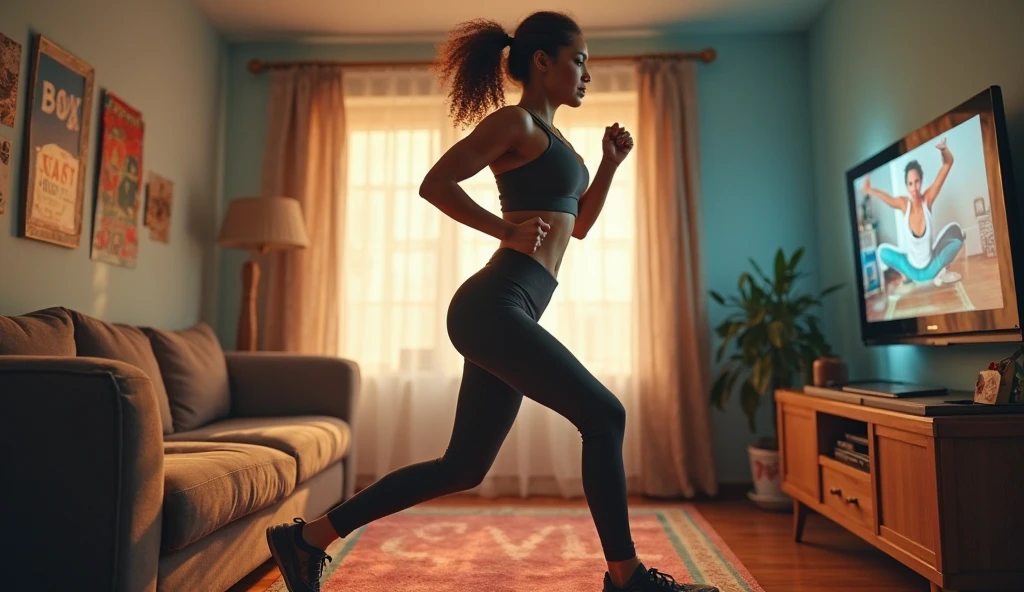
Comment on “Improve Leg Strength: Exercises to Try Today”